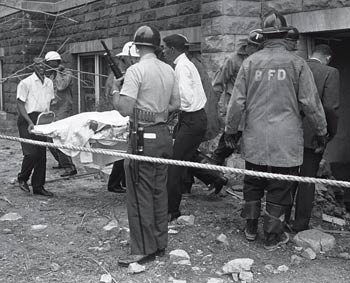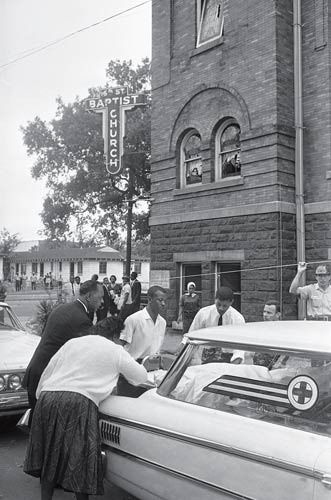A painful U.S. history of Black churches terrorized
By Askia Muhammad -Senior Editor- | Last updated: Jun 23, 2015 - 10:34:24 AMWhat's your opinion on this article?

Ambulance attendants load the body of a Black girl, one of four killed in the bombing of the 16th Avenue Church, Sept. 16, 1963, Birmingham, Ala. Photo: AP/Wide World photos
|
Emanuel A.M.E. Church in Charleston, S.C., which was the site of the killing of nine parishioners including its pastor on June 10, was founded out of protest against White racism in 1816, 199 years ago, by Morris Brown and Denmark Vessey, among others.
The first Black congregation was organized in the 1790s in Philadelphia, when Richard Allen led thousands to form the African Methodist Episcopal Church after they grew tired of being required to pray in the balconies of St. George’s Methodist Church there.
In Charleston in 1822 when he was accused of plotting an elaborate slave rebellion, Mr. Vessey and five others were tortured and executed after a secret trial, and that church was burned to the ground. The church was rebuilt, but in 1834 the laws in South Carolina were changed to require all churches to have a majority of White members, and required that all services attended by Black worshipers be held during the daylight hours. The Emmanuel A.M.E. congregation then met in secret until after the conclusion of the Civil War.
“Understandably, White supremacists have seen Black churches as the citadel of resistance to White supremacy,” Dr. Gerald Horne, professor of history at the University of Houston told The Final Call. Indeed, the sanctuaries have been just that, secure, private places where people met and strategized for relief from slavery and from American apartheid—Jim Crow segregation—for a century and a half after the Civil War.
“We all know that during the Civil Rights era—that is to say, the movement against Jim Crow in the 1950s and 1960s,” Dr. Horne continued, “there were few places where Black people could meet. And so if you look at the history of Mississippi, particularly in the 1950s and 1960s, you’ll find an incredible spate of torchings of Black churches, precisely because they were seen as a safe space for Black people and a safe space for Black people was seen as being antithetical to White supremacy.”

Ambulance attendants load the body of an African American girl, one of four killed in the bombing of the 16th Avenue Church, Sept. 16, 1963, Birmingham, Ala.
|
Before the Charleston church slaughter of 2015, the most horrific attack on a Black church came on Sept. 15, 1963 when Ku Klux Klansmen bombed Birmingham’s 16th Street Baptist Church, killing four teenaged girls—Addie Mae Collins, Denise McNair, Carole Robertson, and Cynthia Wesley.
“It’s entered in the folklore of course, the 1963 bombing of the Birmingham church where four little Black girls were murdered. That took place, not coincidentally just days after the March on Washington of 1963 and was meant as a fitting rebuke to the March on Washington,” said Dr. Horne.
Despite federal legislation which was enacted—and possibly because of it—to remove barriers to public accommodations, to employment, and access to the ballot, the attacks on houses of worship, on Black pastors and their families have continued.
“You may also recall that during the era of the Clinton administration, the Commission on Racial Justice of the United Church of Christ investigated what it perceived to be a wave of torching of Black churches during that particular era,” said Dr. Horne. During the winter of 1995, a string of fires at predominately Black churches began in the South. For a six month period, arsonists set fires across the South and as far north as Delaware and Oklahoma.
But in May, 1996 after its investigation, the U.S. Justice Department’s investigators announced they found no evidence of a widespread conspiracy. Many Southerners however, saw the burnings as part of a larger epidemic: persistent racism and hate. “Therefore, what has happened in Charleston in the last few days should not be seen as overly surprising, but should be seen as consistent with an historical pattern,” Dr. Horne continued.
In fact, one day after the Charleston massacre, a group of Black Richmond, Virginia churchgoers were terrified by a “copy-cat” perpetrator who showed up at their church, threatening to kill everyone inside. “I’m gonna kill all you and you all are gonna get killed tonight,” the cursing man screamed, using racial epithets. A man was taken into custody.
Again, on August 5, 2012, 40-year-old Wade Michael Page—a White supremacist and U.S. Army veteran fatally shot six people and wounded four others at a Sikh temple in Oak Creek, Wisconsin. Mr. Page committed suicide by shooting himself in the head after he was shot in the stomach by a responding police officer.
There is another curious international dimension involved in the Charleston attack, according to Dr. Horne. “Let me also mention this Rhodesian connection, I’m sure you’ve seen the photos of the suspect with the flags of both apartheid South Africa and the late regime of Southern Rhodesia—now known as Zimbabwe of course,” he said.
“You may know I wrote a book on the connections between the United States and the war against the African majority, during the time of the Rhodesian era, that is to say from 1965-1980 and what was striking was the remarkable number of Euro-American men who traveled all the way to Southern Africa to try to keep white supremacy.
“Now that’s nothing new, because if you look at beginnings of the (Rhodesian) colony, as I point out in the book—that is to say the late 19th Century—you’ll find that Euro-American men were in the forefront of establishing that colony. And in fact, as I said in my book on Kenya, the same holds true on colonial Kenya.
“That is to say that Euro-American men were in the forefront of going to Kenya to repress Africans, and therefore it should not be overly surprising that this suspect, his Website as it has just been revealed, was ‘The Last Rhodesian.’ And I think that’s something that should really be taken seriously,” Dr. Horne pointed out.
In addition, he and many others question how this suspect—Dylan Roof—a 21-year-old ninth grade dropout, could have become so “sophisticated” in subtle anti-Black history without mentors and coaches. Authorities and media pundits however, have rushed to label Mr. Roof as a possibly mentally unbalanced, “lone-wolf” psychopath, rather than as a possible “mule” or a hired assassin by some sort of network of race-haters.
“I find it hard to believe that this person, as he has been portrayed, is a lone-wolf-terrorist,” Dr. Horne concluded. “I have to believe there are many more like him. It’s just like when you go in the kitchen and you see one roach, you better believe there are other roaches, they’re just hiding. That’s how I interpret this current suspect.”
INSIDE STORIES AND REVIEWS
-
-
About Harriett ... and the Negro Hollywood Road Show
By Rabiah Muhammad, Guest Columnist » Full Story -
Skepticism greets Jay-Z, NFL talk of inspiring change
By Bryan 18X Crawford and Richard B. Muhammad The Final Call Newspaper @TheFinalCall » Full Story -
The painful problem of Black girls and suicide
By Charlene Muhammad -National Correspondent- » Full Story -
Exploitation of Innocence - Report: Perceptions, policies hurting Black girls
By Charlene Muhammad -National Correspondent- » Full Story -
Big Ballin: Big ideas fuel a father’s Big Baller Brand and brash business sense
By Bryan Crawford -Contributing Writer- » Full Story






 Click Here Stay Connected!
Click Here Stay Connected!








